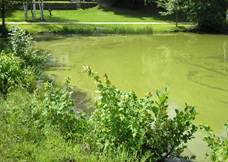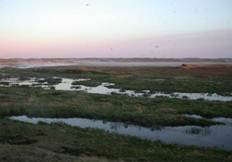Nutrient enrichment (eutrophication)
Another environmental consequence of food production is eutrophication. Ecosystems are affected by substances, which contains nitrogen or phosphorus (e.g. manure/slurry, fertilizer). The consequences of nutrient enrichment are increased biomass production (organic matter) and decreased biodiversity, which arises from increased growth of the relatively few species, which are able to utilize the increased amount of nutrients. Examples can be algae bloom in aquatic ecosystems at the expense of those species flourishing in a relatively nutrient poor environment. A considerable algae growth leads to disappearance of higher plants, and the decomposition of dead algae create a lack of oxygen, which can affect the amount of the more oxygen demanding aquatic animals.
In the same way as GWP is calculated in CO2-eq., the eutrophication potential is calculated in NO3-equivalents (see Table 3).
Table 3. Equivalent factors for GWP and eutrophication
| GWP equivalent factors: | |
| 1 kg carbon dioxide (CO2) | 1 kg CO2-eq. |
| 1 kg methane (CH4) | 25 kg CO2-eq. |
| 1 kg laughing gas (N2O) | 298 kg CO2-eq. |
| Eutrophication equivalent factors: | |
| 1 kg nitrate (NO3) | 1 kg NO3-eq. |
| 1 kg ammonia (NH3) | 3.64 kg NO3-eq. |
| 1 kg phosphate (PO43-) | 10.45 kg NO3-eq. |
|
|
Figure 5. Algae bloom (aquatic ecosystem) and decreased biodiversity
(terrestrial ecosystem) as a consequence of eutrophication

